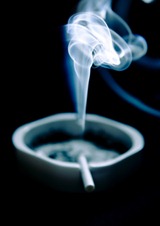Where There’s Smoke, There’s Residue
by Linda Caroll, MSNBC.MSN.COM, December 16,2010
 Pollutants from cigarette smoke may linger long after a smoker has moved out of a home, shows a new study published in Tobacco Control.
Pollutants from cigarette smoke may linger long after a smoker has moved out of a home, shows a new study published in Tobacco Control.
And when nonsmokers move in, they may absorb these toxic chemicals even if the home has been cleaned and vacant for months, researchers found.
The pollutants, which have been labeled “thirdhand smoke,” can coat all the surfaces of a dwelling and seep into every crevice, said the study’s lead author, Georg E. Matt, a professor of psychology at San Diego State University.
“These oily, sticky droplets hang around for months after a smoker has left,” Matt said. “While there was considerably less in homes once an active smoker moved out, there was still 10 to 20 percent of what was found while the smoker still lived there.”
More troubling were the findings of nicotine on or in the bodies of nonsmokers who had moved into dwellings formerly occupied by smokers. Nicotine levels were seven to eight times higher on the fingertips of nonsmokers who’d moved into a smoker’s home compared to nonsmokers who had always lived in a nonsmoking home. Children who’d moved into a home formerly occupied by a smoker had three to five times as much cotinine as those who lived in a nonsmoking home.
-
If you’ve moved into a home that was previously occupied by a smoker, what can you do to minimize the risk that you and your children will be exposed smoke residues?
Experts recommend first that you get rid of carpeting and clean fabrics, such as curtains. Next, you might want to wash down the walls and ceilings and then clean floors with household vinegar, said Georg Matt, professor of psychology at San Diego State University.
Repainting walls might help, but indoor paint won’t necessarily seal in the smoke-related chemicals, Matt said, adding that some pollutants could leak through indoor paint.
Another strategy if you’re not sure about the smoking history of a home is to take samples on your own and send them out to a lab for testing, said Stephanie Land, an associate professor in the department of biostatics at the University of Pittsburgh Cancer Institute.
Further, Land said, there are also companies that clean up homes that have been exposed to tobacco smoke. “I don’t know if there’s any evidence out there to show how effective those companies are, but it might be worth a try.”
In a home were heavy smoking has been going on for years, you might need more drastic measures, such as replacing the dry wall and tiles to get rid of chemical residue, Matt said.
“This is a cool study,” said Dr. Reynold Panettieri, Jr., an expert on the impact of pollutants on lung health and director of the Airways Biology Initiative at the University of Pennsylvania School of Medicine. “It was meticulously done. And while we don’t yet know the health consequences of thirdhand smoke, you have to remember that it took 20 years before we realized that smoking could lead to cancer and another 20 before we realized secondhand smoke could lead to cardiovascular disease.”
Until we learn more about the impact of thirdhand smoke, it might make sense to err on the side of caution, especially when it comes to small children, said Stephanie Land, an associate professor in the department of biostatics at the University of Pittsburgh Cancer Institute. [Read rest of story]


